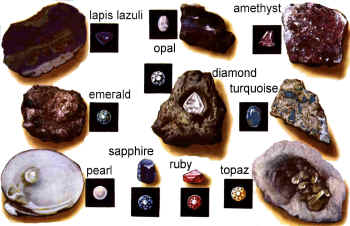 A
gem can be organic or inorganic, natural or human-made. They can be
minerals, rocks, or anything that has been given monetary value. Only
about 80 minerals are considered gemstones, and probably only about 30
are commonly found in jewelry stores. Examples of mineral gemstones
include garnet, hematite, and diamond. A
gem can be organic or inorganic, natural or human-made. They can be
minerals, rocks, or anything that has been given monetary value. Only
about 80 minerals are considered gemstones, and probably only about 30
are commonly found in jewelry stores. Examples of mineral gemstones
include garnet, hematite, and diamond.
Some minerals are given a specific gem name which
is different from its mineral name. For example beryl is the mineral
name, while the green variety is called an emerald. Corundum is the
mineral name for both sapphires (blue variety) and rubies (red variety).
Some minerals are not minerals because they are
organic in nature. A pearl, although mainly calcium carbonate, is
produced by a mollusk. Amber, or fossilized tree resin is also
considered a gemstone. Other gemstones are really rocks, which are
multiple minerals. An example is polished granite or obsidian. Finally,
some gemstones arenít technically minerals because they are amorphous
materials or lacking a regular crystal structure. Water within the
chemical make-up of opal, creates an unorganized crystal
structure.
|